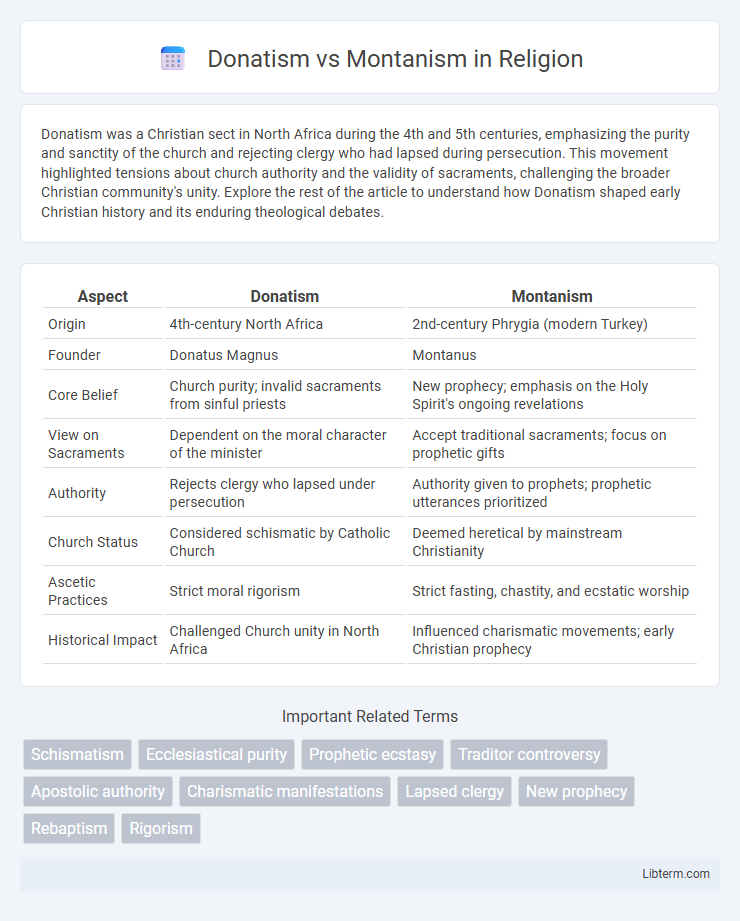Donatism was a Christian sect in North Africa during the 4th and 5th centuries, emphasizing the purity and sanctity of the church and rejecting clergy who had lapsed during persecution. This movement highlighted tensions about church authority and the validity of sacraments, challenging the broader Christian community's unity. Explore the rest of the article to understand how Donatism shaped early Christian history and its enduring theological debates.
Table of Comparison
| Aspect | Donatism | Montanism |
|---|---|---|
| Origin | 4th-century North Africa | 2nd-century Phrygia (modern Turkey) |
| Founder | Donatus Magnus | Montanus |
| Core Belief | Church purity; invalid sacraments from sinful priests | New prophecy; emphasis on the Holy Spirit's ongoing revelations |
| View on Sacraments | Dependent on the moral character of the minister | Accept traditional sacraments; focus on prophetic gifts |
| Authority | Rejects clergy who lapsed under persecution | Authority given to prophets; prophetic utterances prioritized |
| Church Status | Considered schismatic by Catholic Church | Deemed heretical by mainstream Christianity |
| Ascetic Practices | Strict moral rigorism | Strict fasting, chastity, and ecstatic worship |
| Historical Impact | Challenged Church unity in North Africa | Influenced charismatic movements; early Christian prophecy |
Introduction to Donatism and Montanism
Donatism was an early Christian movement that emerged in North Africa during the 4th century, emphasizing the purity and sanctity of the church and condemning clergy who had lapsed during persecution. Montanism, originating in the 2nd century, centered on ecstatic prophecy and strict moral rigor, claiming new revelations from the Holy Spirit through its founders Montanus and his prophetesses. Both movements challenged the established church's authority by prioritizing spiritual purity and prophetic authority over institutional tradition.
Historical Context and Origins
Donatism emerged in the early 4th century North African Church as a response to the Diocletian persecution, emphasizing the purity and sanctity of the clergy and rejecting the validity of sacraments performed by priests who had lapsed. Montanism originated in the late 2nd century Phrygia, founded by Montanus, centering on new prophetic revelations and a rigorous moral code aimed at preparing for the imminent Second Coming of Christ. Both movements highlight early Christian tensions over authority, holiness, and the interpretation of Christian doctrine within distinct historical contexts.
Core Beliefs of Donatism
Donatism emphasized the purity and sanctity of the church, asserting that the validity of sacraments depended on the moral character of the clergy administering them. Donatists rejected the legitimacy of clergy who had lapsed during persecution, especially those who handed over scriptures to Roman authorities. This strict view contrasted with Montanism, which centered on prophetic revelations and the imminent apocalypse rather than ecclesiastical purity.
Core Beliefs of Montanism
Montanism emphasized the ongoing presence and guidance of the Holy Spirit through prophetic revelations, advocating for rigorous moral purity and strict ascetic practices. Montanists believed in imminent eschatology, expecting the New Jerusalem to descend in Phrygia, where their prophet-leaders claimed divine inspiration. This movement contrasted with Donatism's focus on church purity and the invalidity of sacraments administered by traditores, highlighting Montanism's charismatic and visionary core beliefs.
Key Figures and Leaders
Donatism was led primarily by Donatus Magnus, a North African bishop who emphasized the purity of the Church and rejected clergy who had lapsed during persecution. Montanism, founded by Montanus in Phrygia, featured prophetic leaders including two prophetesses, Prisca and Maximilla, who emphasized strict moral rigor and new revelations. Both movements challenged mainstream Christianity by asserting alternative authority through charismatic leaders and divergent theological views.
Doctrinal Differences
Donatism emphasized the purity and sanctity of the church, insisting that clergy who lapsed during persecution could not administer valid sacraments, whereas Montanism focused on ongoing prophecy and the imminent apocalypse, advocating for strict moral rigor and new revelations through the Holy Spirit. Donatists rejected the efficacy of sacraments performed by traditores, highlighting ecclesiastical purity, while Montanists promoted charismatic gifts and ecstatic prophecy as central to Christian life. These doctrinal contrasts reveal Donatism's institutional concern with church legitimacy and Montanism's emphasis on spiritual renewal and prophetic authority.
Attitudes Toward Church Authority
Donatism emphasized the purity and moral integrity of clergy, rejecting sacraments performed by priests or bishops who had lapsed in faith, thus challenging the universal authority of the church hierarchy. Montanism advocated for direct prophetic revelations from the Holy Spirit and stricter moral rigor, often bypassing established ecclesiastical authority in favor of charismatic leadership. Both movements contested mainstream church authority, but Donatism did so through legalistic ecclesiastical purity, while Montanism promoted spiritual newness and immediate divine guidance.
Impact on Early Christian Communities
Donatism deeply influenced early Christian communities by fostering rigid views on church purity and the legitimacy of sacraments, leading to significant schisms in North Africa during the 4th century. Montanism emphasized prophetic gifts and strict moral rigor, challenging established ecclesiastical authority and encouraging charismatic expressions within congregations in the 2nd century. Both movements prompted debates on church authority and discipline, shaping the development of early Christian theology and community boundaries.
Church Responses and Controversies
The Church condemned Donatism for its rigorist stance on the sanctity of clergy and the validity of sacraments, asserting that the efficacy of sacraments depends on the Church's unity rather than the moral purity of ministers. Montanism faced rejection due to its promotion of new prophetic revelations and strict asceticism, which threatened ecclesiastical authority and doctrinal stability. Both controversies highlighted early Church efforts to maintain doctrinal unity and hierarchical control while addressing divergent theological and disciplinary challenges.
Legacy and Influence on Christianity
Donatism left a lasting legacy by emphasizing church purity and the validity of sacraments dependent on clergy morality, influencing later debates on ecclesiastical authority and ecclesial identity. Montanism contributed to the development of charismatic spirituality by stressing prophecy, rigorous asceticism, and direct revelation from the Holy Spirit, shaping early Christian views on prophecy and the role of the Holy Spirit. Both movements challenged institutional church norms, prompting the early church to define orthodoxy and reinforce hierarchical structures.
Donatism Infographic

 libterm.com
libterm.com